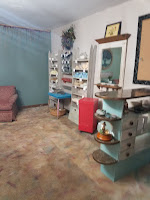Amelia Earhart
1897-1937
What young girl hasn't admired Amelia Earhart? She has always been a heroine of mine. During a time when women didn't even conceive of flying, she became the first woman pilot. She studied successful women, even making a scrapbook of the accomplishments of others. Amelia is definitely one woman to add to your studies of successful women.

July 24, 1897 - Born on July 24, 1897, Earhart, as a child, spent long hours playing with Pidge, climbing trees, hunting rats with a .22 rifle and belly-slamming her sled downhill. Amelia Mary Earhart saw her first plane at a state fair at the age of 10, and she was not impressed.
December 28, 1920 - Pilot Frank Hawks gave her a ride that would forever change her life. "By the time I had got two or three hundred feet off the ground," she said, "I knew I had to fly."
January 3, 1921 - Began flying lessons with Neta Snook
July 1921 - Bought first plane, Kinner Airster (Canary)
October 22, 1922 - Broke women's altitude record when she rose to 14,000 feet
June 17-18, 1928 - First woman to fly across the Atlantic; 20hrs 40min (Fokker F7, Friendship)
Summer 1928 - Bought an Avro Avian, a small English plane famous because Lady Mary Heath, Britain's foremost woman pilot had flown it solo from Capetown, South Africa to London
Fall 1928 - Published book 20 Hours 40 Minutes, toured and lectured; became aviation editor of Cosmopolitan magazine
August 1929 - Placed third in the First Women's Air Derby, aka the Powder Puff Derby; upgraded from her Avian to a Lockheed Vega
Fall 1929 - Elected as an official for National Aeronautic Association and encouraged the Federation Aeronautique Internationale (FAI) to establish separate world altitude, speed and endurance records for women
June 25, 1930 - Set women's speed record for 100 kilometers with no load, and with a load of 500 kilograms
July 5, 1930 - Set speed record for of 181.18mph over a 3K course
September 1930 - Helped to organize and became vice president of public relations for new airline, New York, Philadelphia and Washington Airways
April 8, 1931 - Set woman's autogiro altitude record with 18,415 feet (in a Pitcairn autogiro)
May 20-21, 1932 - First woman to fly solo across the Atlantic; 14 hrs 56 min (it was also the 5th anniversary of Lindberg's Atlantic flight; awarded National Geographic Society's gold medal from President Herbert Hoover; Congress awarded her the Distinguished Flying Cross; wrote For The Fun of It about her journeyAugust 24-25, 1932 - First woman to fly solo nonstop coast to coast; set women's nonstop transcontinental speed record, flying 2,447.8 miles in 19hrs 5min
Fall 1932 - Elected president of the Ninety Nines, a new women's aviation club which she helped to form
July 7-8, 1933 - Broke her previous transcontinental speed record by making the same flight in 17hrs 7min
January 11, 1935 - First person to solo the 2,408-mile distance across the Pacific between Honolulu and Oakland, California; also first flight where a civilian aircraft carried a two-way radio
April l9 - 20, 1935 - First person to fly solo from Los Angeles to Mexico City; 13hrs 23min
May 8, 1935 - First person to fly solo nonstop from Mexico City to Newark; 14hrs 19min
June 1, 1937 - Began flight around the world June 1937; first person to fly from the Red Sea to India.
July 2, 1937 - Amelia Earhart left with her crew member from New Guinea and disappeared near Howland Island.
 Anna sees the ballet performance of The Sleeping Beauty at the age of 8 and knows immediately she wants to learn ballet.
Anna sees the ballet performance of The Sleeping Beauty at the age of 8 and knows immediately she wants to learn ballet.











































